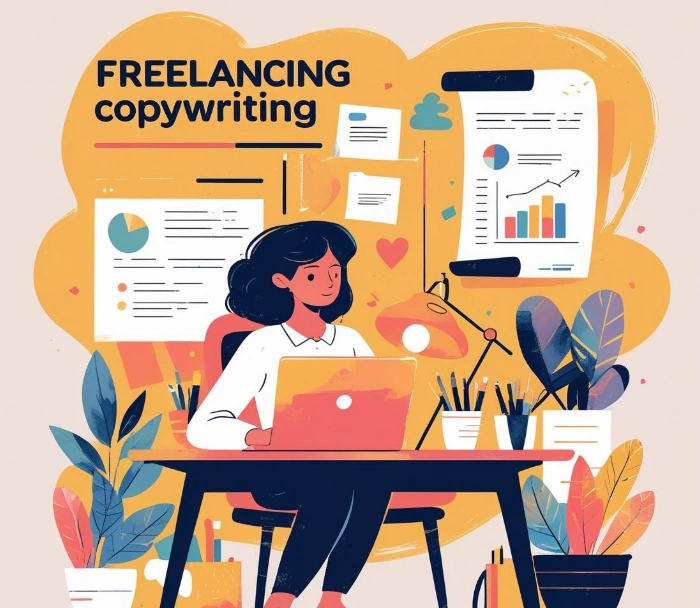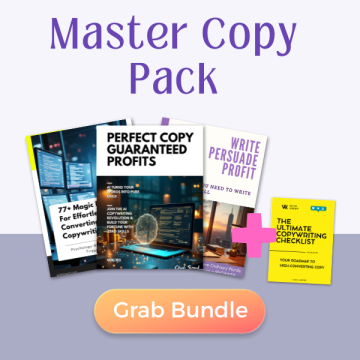Looking at freelance copywriting examples feels like peeking into someone else’s diary, doesn’t it? You’re curious, maybe a little intimidated, but definitely hungry for insights. I get it—when I started copywriting three years ago, I spent hours studying other writers’ work, wondering how they made words dance off the page while mine felt like they were doing the robot.
Here’s the thing: freelance copywriting examples aren’t just pretty portfolios to admire. They’re your roadmap to understanding what clients actually want. And trust me, after analyzing hundreds of samples and building my own six-figure copywriting business, I’ve cracked the code on what makes copy convert and portfolios irresistible.
Ready to dive into real examples that’ll transform your writing game? Let’s go.
What Makes Freelance Copywriting Examples Actually Worth Studying?
Not all copywriting samples are created equal. Some make you want to buy immediately. Others make you scroll past faster than a bad dating profile.
The difference? Strategy, not just pretty words.
Great freelance copywriting examples share three core elements:
• Clear audience targeting – They speak directly to one specific person • Measurable results – They include conversion rates, open rates, or sales figures
• Strategic structure – Every sentence serves a purpose
I learned this the hard way when my first portfolio got zero responses. My samples looked nice but had no soul—or sales power.
Related articles:
- Copywriting Examples Advertising: 27 Ads That Actually Convert
- Landing Page Copywriting Examples: 12 Winning Formulas
- Good Copywriting Examples: 15 Templates That Actually Convert
Email Copywriting Examples That Convert Like Crazy
Email copy might look simple, but it’s pure psychology wrapped in pixels. Let me show you what separates amateur hour from the pros.
Welcome Email Series That Actually Welcomes
Subject: “Your pizza’s ready (and so are your marketing superpowers)”
This subject line from a marketing agency doesn’t just grab attention—it creates intrigue. Notice how it connects something familiar (pizza delivery) with the service promise (marketing superpowers).
The body copy continues:
“Sarah, remember that feeling when your favorite pizza place knows your order by heart? That’s what we’re building here—except instead of extra cheese, you’re getting extra clients.”
Why it works: Personal connection + clear benefit + conversational tone.
Cart Abandonment Emails That Rescue Sales
Subject: “Did your wifi hiccup, or did we mess up?”
This e-commerce example turns a potential negative (abandoned cart) into genuine concern. The email continues with helpful suggestions rather than pushy sales tactics.
Smart copy acknowledges real problems people face instead of assuming they’re just indecisive.
Website Copy Examples That Turn Visitors Into Customers
Your website homepage has about three seconds to make an impression. These examples nail it.
SaaS Landing Pages That Simplify Complex Ideas
Headline: “Stop losing customers to confusing checkout pages”
This B2B software company skips the tech jargon and hits the pain point directly. The subheader explains the solution in plain English:
“Our checkout optimizer reduces cart abandonment by 34% without any coding required.”
See how specific that number is? That’s not an accident—specificity builds trust.
Service-Based Business Copy That Builds Authority
Headline: “The marketing consultant who actually shows up on time (and delivers results)”
This consultant’s homepage tackles two common pain points: reliability and effectiveness. The copy continues with client testimonials that include specific revenue increases.
Authority isn’t about fancy credentials—it’s about solving real problems consistently.
Sales Page Examples That Actually Sell
Sales pages separate good copywriters from great ones. Here’s what works.
Course Sales Pages That Educate While They Sell
The best course sales pages don’t feel salesy at all. They teach valuable concepts while positioning the paid course as the natural next step.
One fitness coach’s sales page starts with:
“The reason your abs aren’t showing has nothing to do with your workout routine.”
Then it explains the real culprit (nutrition timing) before introducing the course that solves it. Educational selling beats pushy tactics every time.
Product Sales Pages That Handle Objections
Smart product pages address every possible “but what if” before customers think it.
One skincare brand includes this section:
“But what if I have sensitive skin?” “But what if it doesn’t work for me?” “But what if I’m already using other products?”
Each objection gets a clear, confident answer. Uncertainty kills sales—clarity creates them.
Social Media Copy Examples That Stop the Scroll
Social media copy needs to work instantly or it doesn’t work at all. These examples understand the assignment.
LinkedIn Posts That Generate Leads
“I made a $50,000 mistake so you don’t have to.”
This opening hook guarantees people will keep reading. The post continues with specific lessons learned, then subtly mentions the writer’s consulting services at the end.
LinkedIn loves vulnerability mixed with expertise. Give valuable insights, show your human side, and the leads follow naturally.
Instagram Captions That Drive Action
“Swipe to see why your competitor’s Instagram looks better than yours (hint: it’s not the camera).”
This caption creates curiosity while promising actionable insights. The carousel post delivers design tips, then ends with a call-to-action for design services.
Instagram success comes from teaching first, selling second.
Ad Copy Examples That Generate Clicks and Conversions
Paid advertising copy faces the ultimate test—people vote with their wallets. These examples passed that test.
Facebook Ad Copy That Hooks Immediately
“Tired of marketing advice from 23-year-olds who’ve never run a real business?”
This ad targets the specific frustration of experienced entrepreneurs. It continues by highlighting the advertiser’s 20+ years of business experience.
Great ad copy identifies a specific annoyance, then positions your solution as the obvious choice.
Google Ad Copy That Wins Despite Character Limits
“Website broken? Fixed in 24 hours or free.”
This Google ad headline does three things in six words: identifies the problem, promises fast solution, and removes risk.
When space is limited, every word must earn its place.
Blog Post Examples That Build Authority and Generate Leads
Blog posts serve dual purposes—they educate readers and demonstrate your expertise to potential clients.
How-to Posts That Actually Help
The best marketing blogs don’t just share tips—they share complete systems. One digital marketing agency’s blog post titled “The 48-Hour Client Acquisition System” includes:
• Detailed daily schedules • Email templates • Scripts for sales calls • Case study results
This level of detail proves competence while building trust. When someone needs deeper help, they know exactly who to call.
Case Study Posts That Prove Results
“How we increased this client’s revenue by 312% in 90 days”
Case studies work because they tell stories with numbers. This post breaks down the strategy, shows before/after metrics, and explains the specific tactics used.
Smart case studies don’t just brag about results—they teach the methodology behind them.
How to Build Your Own Portfolio (Even With Zero Experience)
Here’s where most beginner copywriters get stuck. You need examples to get clients, but you need clients to get examples. It’s the classic catch-22.
But I’ve got your solution.
Create Spec Work That Doesn’t Suck
Spec work means writing samples for fictional clients. The key is making them realistic, not generic.
Instead of writing for “a fitness company,” write for: “Sarah’s Strength Studio – helping busy mothers reclaim their confidence through 30-minute strength workouts”
Specific businesses attract specific clients. Generic businesses attract nobody.
Volunteer Your Skills Strategically
Local nonprofits need copy but often can’t afford professional writers. Offer to rewrite their donation page or newsletter in exchange for a testimonial and permission to use the work in your portfolio.
You get real samples with real results. They get better fundraising copy. Everybody wins.
Study and Rewrite Existing Copy
Find a sales page or email that could use improvement. Rewrite it, then create a before/after case study showing your strategic thinking.
This approach demonstrates analytical skills while showcasing your writing ability.
Common Portfolio Mistakes That Kill Your Chances
I’ve reviewed thousands of copywriting portfolios. These mistakes appear constantly—and they’re all fixable.
Mistake #1: No Context or Strategy
Bad portfolio sample: Just the copy with no explanation.
Good portfolio sample: Copy plus brief explaining the target audience, goals, and results (or projected results for spec work).
Clients don’t just want good writing—they want strategic thinking.
Mistake #2: Too Much Variety, No Specialization
Jack-of-all-trades copywriters often struggle to get hired because clients can’t figure out if they’re the right fit.
Better approach: Choose 2-3 specialties (like email marketing and sales pages) and become known for those.
Mistake #3: Focusing on Features Instead of Results
Weak description: “I wrote a 500-word blog post about social media marketing.”
Strong description: “This blog post generated 47 leads and became the client’s most-shared content piece.”
Results matter more than word counts.
Frequently Asked Questions
Q: How many examples should I include in my portfolio?
A: Quality beats quantity every time. 5-8 strong, diverse samples work better than 20 mediocre ones. Each piece should showcase different skills or industries.
Q: Can I use spec work in my professional portfolio?
A: Absolutely, as long as you’re transparent about it. Label spec work clearly and explain your strategic thinking. Many successful copywriters started with spec samples.
Q: How do I price my services as a beginner?
A: Start with project-based pricing rather than hourly rates. Research industry standards, then price slightly below market rate while you build experience and testimonials.
Q: What if I don’t have any writing experience at all?
A: Everyone starts somewhere. Focus on transferable skills from your previous career. Did you write reports? Create presentations? Send persuasive emails? That’s copywriting experience—you just haven’t packaged it yet.
Q: Should I create a website for my portfolio?
A: Yes, but keep it simple. A basic WordPress site with your best samples, an about page, and contact information is sufficient. Don’t let perfectionism delay your launch.
Ready to Build Your Copywriting Portfolio?
Great freelance copywriting examples aren’t accidents—they’re the result of understanding your audience, crafting strategic messages, and presenting them professionally.
Start small. Pick one type of copy that interests you (emails, sales pages, ads) and create three strong samples. Study successful examples in that niche. Practice until your samples match that quality level.
Remember, every expert copywriter started with zero samples and zero clients. The difference between dreamers and doers? Doers start creating samples today instead of waiting for perfect conditions tomorrow.
Your copywriting career begins with that first sample. What are you waiting for?

